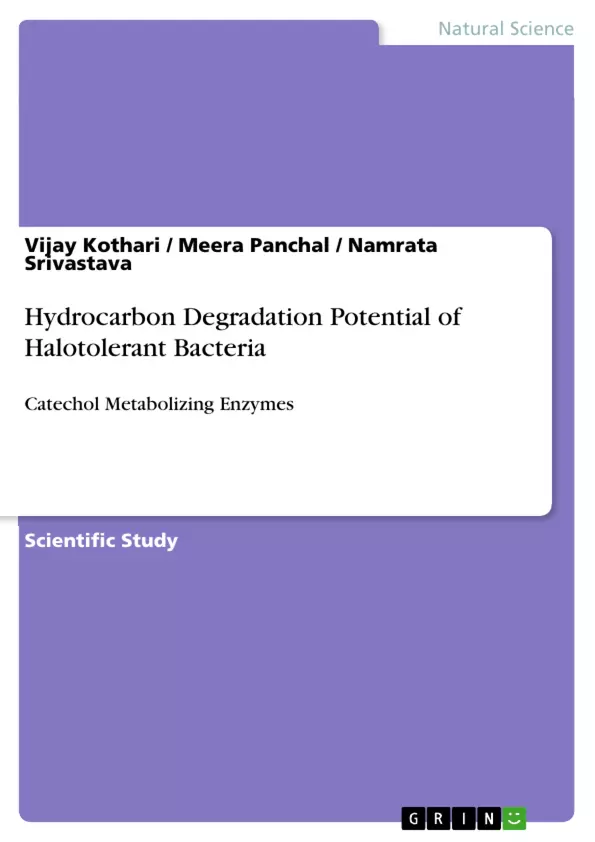Hydrocarbon contamination of marine ecosystems has been a major environmental concern. Hydrocarbon metabolizing capacity of four halotolerant bacteria (Bacillus atrophaeus, Halomonas shengliensis, Halomonas koreensis, and Virgibacillus salarius) isolated from saline soil of Khambhat, India was investigated. Presence of catechol metabolizing enzymes (catechol 2,3 dioxygenase, chlorocatechol 1,2 dioxygenase, and protocatechuate 3,4 dioxygenase) was checked in V. salarius, as only this among all the test organisms could grow on the hydrocarbon substrates used, and compared with Pseudomonas oleovorans. Effect of salinity of the growth medium on activity of catechol metabolizing enzymes was also studied. Catechol 2,3 dioxygenase activity in both the organisms was more susceptible to increase in salinity of the growth medium than chlorocatechol 1,2-dioxygenase activity. To the
best of our awareness, this is the first report of catechol metabolism in V. salarius. V. salarius was found to be capable of weak biofilm formation. As V. salarius is capable of growing at high salt concentration, alkaline pH, hydrocarbon degradation, and also of growth in presence of various metal ions, it can be an attractive candidate for bioremediation of marine oil spills. Organisms like V. salarius can also serve as a model for multiple stress tolerance in prokaryotes.
Inhaltsverzeichnis (Table of Contents)
- Introduction
- Objectives
- Bioremediation
- Hydrocarbon overview
- Need for biodegradation
- Approaches to biodegradation of hydrocarbons
- Laboratory methods for studying hydrocarbon degradation
- Microorganisms known to degrade hydrocarbons
- Enzymes involved in hydrocarbon degradation
- Factors affecting hydrocarbon degradation
- Salinity and hydrocarbon degradation
- Test organisms
- Methodology
- Materials
- Instruments
- Test organisms
- Preliminary qualitative analysis
- Cell lysis
- Enzyme assay: catechol 2,3 dioxygenase
- Enzyme assay: chlorocatechol 1,2-dioxygenase
- Enzyme assay: protocatechuate 3,4-dioxygenase
- Biofilm formation
- Estimation of biofilm formation by crystal violet assay
- Effect of microwave radiation on enzyme activity
- Findings
- Qualitative analysis
- Enzyme activity
- Effect of salinity on enzyme activity
- Biofilm formation
Zielsetzung und Themenschwerpunkte (Objectives and Key Themes)
This research investigates the potential of halotolerant bacteria to degrade hydrocarbons, focusing on the role of specific enzymes and the impact of salinity. The research aims to contribute to a deeper understanding of bioremediation strategies for contaminated environments.- Hydrocarbon biodegradation by halotolerant bacteria
- Enzymes involved in hydrocarbon degradation
- Impact of salinity on hydrocarbon degradation
- Biofilm formation by halotolerant bacteria
- Potential applications for bioremediation
Zusammenfassung der Kapitel (Chapter Summaries)
The introduction provides an overview of hydrocarbon pollution, the need for bioremediation, and different approaches to hydrocarbon degradation. It explores the role of microorganisms and enzymes in the degradation process, highlighting the influence of factors like salinity. The methodology chapter outlines the materials, instruments, and procedures employed in the study, including tests for enzyme activity and biofilm formation. The findings chapter presents the results of qualitative analysis, enzyme activity assays, and the impact of salinity on enzyme activity. It also explores the formation of biofilms by halotolerant bacteria.
Schlüsselwörter (Keywords)
The study focuses on halotolerant bacteria, hydrocarbon degradation, bioremediation, enzymes, salinity, and biofilm formation. It explores the potential of these microorganisms for cleaning up contaminated environments and contributes to the understanding of microbial processes in saline conditions.- Quote paper
- Assistant Professor Vijay Kothari (Author), Meera Panchal (Author), Namrata Srivastava (Author), 2013, Hydrocarbon Degradation Potential of Halotolerant Bacteria, Munich, GRIN Verlag, https://www.grin.com/document/268982



